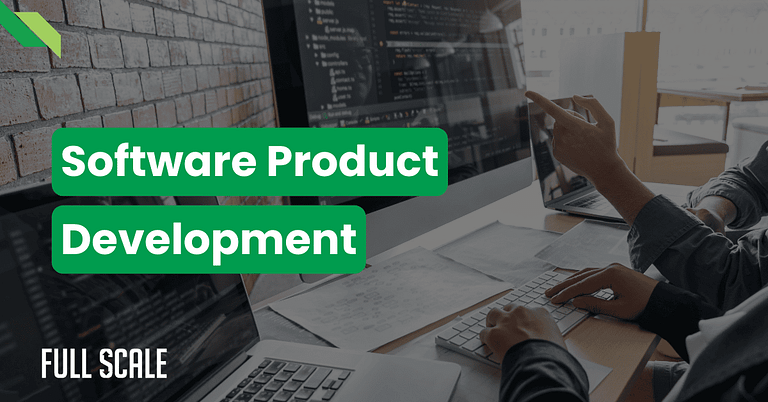Last Updated on 2025-06-13
The landscape of software product development has undergone a dramatic transformation in the last quarter of 2024.
With global enterprises investing heavily in digital transformation, custom software solutions have become the cornerstone of business innovation and growth. Market research reveals that companies leveraging custom software product development services gain a significant competitive advantage, with a 42% higher market adaptation rate than their competitors.
The drive toward digital excellence has created unprecedented demand for sophisticated software solutions.
Recent analysis from Gartner indicates that the global custom software development market will reach $692.5 billion by the end of 2024. This surge reflects both the growing recognition of software’s strategic importance and the increasing complexity of business challenges that require tailored solutions.
Whether you’re a startup founder crafting your first minimum viable product or an enterprise leader modernizing legacy systems, understanding the intricacies of software product development is crucial for success.
This comprehensive guide explores the essential aspects of building successful software products, from initial conception through deployment and maintenance. We’ll examine how partnering with the right software product development company can transform your business vision into a market-ready solution that drives growth and innovation.
Understanding the Software Product Development Lifecycle
The evolution of software development has created a sophisticated process that goes far beyond simple coding. Modern software product development encompasses a comprehensive journey from concept to market-ready solution, requiring careful orchestration of various elements and expertise.
Companies that master this process report 35% higher success rates in their digital initiatives.
Defining Modern Software Product Development
Software product development represents the systematic process of creating, testing, and deploying software solutions that address specific business challenges. Unlike traditional software development, the product-focused approach emphasizes market viability, user experience, and long-term sustainability. This holistic view ensures that the final product not only functions technically but also delivers measurable business value.
1. Business Process Optimization Impact
The integration of custom software solutions into business operations has revolutionized how companies function. Organizations implementing tailored software product development services report an average 40% improvement in operational efficiency. This enhancement stems from automated workflows, streamlined processes, and data-driven decision-making capabilities that custom solutions provide.
2. Competitive Edge Through Customization
Market research in 2024 demonstrates that businesses utilizing custom software solutions gain significant advantages over competitors using off-the-shelf products. These companies experience 42% higher customer satisfaction rates and 38% better market responsiveness. The ability to rapidly adapt features and functionality to changing market conditions provides an agility that standard solutions cannot match.
3. Long-term Value Creation
The investment in custom software product development yields substantial long-term benefits. Studies show that organizations with customized solutions achieve:
Sustainable Growth
Companies report an average 45% reduction in operational costs over three years, coupled with a 30% increase in business agility.
Market Adaptability
Custom solutions enable 60% faster response to market changes compared to businesses relying on standard software packages.
Innovation Capability
Organizations with custom software demonstrate 50% higher rates of successful innovation initiatives.
4. Risk Mitigation and Quality Assurance
Modern software product development emphasizes comprehensive quality assurance throughout the development lifecycle. This proactive approach reduces post-launch issues by 65% and ensures compliance with industry standards and regulations.
Understanding these core elements and their interrelationships is the foundation of successful software product development. As we examine the strategic planning phase, this understanding will inform decisions about methodology, resource allocation, and implementation approaches.
Two Most Important Tips When Starting a Software Product Development Plan
The journey from concept to successful software product begins with strategic planning.
In 2024, organizations investing in comprehensive planning report 2.5 times higher success rates in their development initiatives.
1. Envision Your Product
Product vision serves as your project’s North Star, guiding every subsequent decision in the development process. Healthcare software product development companies, for instance, have seen 42% fewer compliance issues and 38% higher user adoption rates when starting with a clear vision.
In the competitive software product development landscape, your vision must address specific market needs while differentiating your solution. This involves deep market analysis, user research, and competitive positioning. Companies that invest adequate time in vision development experience 40% fewer pivots during the development phase.
2. Create a Roadmap
A well-structured roadmap transforms your vision into actionable steps. Software product development services implementing detailed roadmaps report 65% higher stakeholder satisfaction and improved alignment between business and technical teams.
The roadmap should outline your minimum viable product software development strategy, helping validate core features quickly while minimizing initial investment. Organizations using this approach achieve 45% faster time to market and 30% lower development costs.
Roadmap Implementation for Maximum Impact
Implementing your roadmap requires careful orchestration of resources, timing, and methodologies. Custom software product development teams establishing clear implementation frameworks report 34% faster time-to-market while maintaining higher quality standards.
This phase becomes even more critical when considering outsourced software product development options. Companies that establish clear communication protocols and project milestones with their development partners experience 40% fewer project delays and better outcomes.
To support this coordination, many teams are turning to AI tools for product managers to streamline planning, anticipate risks, and improve decision-making throughout the development cycle.
The strategic planning phase lays the groundwork for successful execution.
7 Essential Steps in Software Product Development
The software product development lifecycle follows a systematic progression that transforms concepts into market-ready solutions. Whether partnering with software product development companies or building in-house, understanding these steps ensures project success and optimal outcomes.
Step 1: Strategic Ideation and Concept Validation
The foundation of successful custom software product development begins with robust ideation. This critical phase goes beyond basic conceptualization, requiring deep market analysis and user research. Healthcare software product development teams, for example, report 45% higher success rates when conducting thorough user research before development begins.
Step 2: Comprehensive Requirements Analysis
During this phase, software product development companies evaluate technical feasibility while defining detailed requirements. Recent studies show that organizations spending adequate time on requirement analysis reduce development costs by 30% and improve delivery accuracy by 40%.
Step 3: User-Centric Design Planning
Product design transforms requirements into actionable blueprints. Leading software product development services emphasize user experience here, as good design significantly impacts adoption rates. Companies investing in comprehensive design phases report 35% higher user satisfaction rates.
Step 4: Core Development Implementation
The development phase brings your minimum viable product software development strategy to life. Whether utilizing in-house resources or engaging in offshore software product development, maintaining coding standards and documentation is crucial. Organizations following structured development processes report 50% fewer bugs and 40% faster deployment times.
Step 5: Comprehensive Testing and Quality Assurance
Quality assurance within the software product development lifecycle cannot be overstated. Companies implementing comprehensive testing strategies across their custom software product development projects experience:
- 65% reduction in post-launch issues
- 40% decrease in maintenance costs
- 55% improvement in user satisfaction
Step 6: Market Validation and Deployment
Successful software product development service providers emphasize market testing before full-scale deployment. This phase validates your product’s market fit and identifies any necessary adjustments. Companies conducting thorough market testing report 38% higher adoption rates in their first year.
Step 7: Continuous Improvement and Support
The software product development process extends well beyond launch. Ongoing maintenance ensures your product evolves with user needs and market demands. Organizations with structured maintenance programs report 45% higher customer retention rates and 30% lower long-term support costs.
Understanding these essential steps provides context for selecting the right development methodology for your project. In the next section, we’ll explore how different methodologies can optimize each step of your development journey.
Software Product Development Methodologies for Modern Teams
Selecting the right methodology significantly impacts your software product development life cycle. Recent studies show that aligning methodology with project needs increases success rates by 35%. In today’s rapidly evolving digital landscape, understanding these methodologies becomes crucial for project success.
1. Agile Framework in Custom Software Development
Agile methodology has revolutionized custom software product development services. This iterative approach particularly benefits healthcare software product development teams, where regulatory requirements and user needs frequently evolve. The 2024 State of Agile report indicates that organizations implementing Agile report 40% faster time-to-market and 35% higher team productivity. I’m
The strength of Agile lies in its adaptability. Software product development companies utilizing Agile methodologies demonstrate 50% better stakeholder engagement and 45% higher customer satisfaction rates. This approach proves especially valuable when requirements evolve throughout the development process.
2. Scrum Implementation for Product Development
Among software product development companies, Scrum remains the preferred Agile framework. This structured approach excels in minimum viable product software development, allowing teams to deliver value incrementally while maintaining quality. Recent data shows companies using Scrum experience 45% improved requirement fulfillment and a 30% reduction in development costs.
The structured nature of Scrum provides clear frameworks for team collaboration and project progression. When implementing Scrum properly, organizations report 55% better team collaboration and 40% improved project visibility.
3. DevOps Integration Strategy
DevOps has become integral to outsourced software product development success. This methodology bridges development and operations, creating a seamless pipeline for product delivery. Companies integrating DevOps into their software product development process achieve 60% faster deployment cycles and 45% fewer production issues.
Modern software product development services increasingly rely on DevOps to maintain continuous delivery pipelines. This approach ensures consistent quality while enabling rapid response to market changes.
4. Waterfall Approach for Specific Scenarios
While less common in modern software product development services, the Waterfall methodology remains valuable for certain projects. This approach particularly suits offshore software product development projects where requirements are well-defined and stable. Organizations using Waterfall report 40% better documentation quality and 35% improved regulatory compliance.
The structured nature of Waterfall provides clear milestones and comprehensive documentation, making it ideal for projects with fixed requirements and regulatory obligations.
5. Hybrid Development Approaches
Many software product development companies now adopt hybrid methodologies, combining elements from different approaches. This flexibility particularly benefits custom software product development projects, allowing teams to adapt to changing requirements while maintaining quality standards.
The hybrid approach enables organizations to optimize resource allocation, meet diverse client needs, and maintain project control and visibility.
Comparing Software Development Methodologies
When selecting a methodology for your software product development service, various factors require careful consideration. The following comparison highlights key aspects of each methodology based on data from successful software product development companies in 2024:
| Methodology | Best Suited For | Time to Market | Cost Efficiency | Flexibility | Documentation | Best Use Case |
| Agile | Custom software product development with evolving requirements | Fast (2-4 weeks per iteration) | High (35% cost reduction) | Very High | Moderate | Healthcare software product development, startups |
| Scrum | Minimum viable product software development | Very Fast (1-2 weeks per sprint) | Very High (40% savings) | High | Low | Complex products requiring rapid iteration |
| DevOps | Continuous delivery projects | Fastest (Daily/Weekly releases) | High (45% efficiency gain) | Moderate | High (Automated) | Large-scale enterprise solutions |
| Waterfall | Offshore software product development with fixed requirements | Slow (6+ months) | Moderate | Low | Very High | Government/regulated projects |
| Hybrid | Custom software product development services needing flexibility | Moderate | High (30% savings) | Very High | Moderate-High | Multi-faceted projects |
This comparison demonstrates that no single methodology provides a universal solution for all software product development scenarios. Success lies in aligning your chosen methodology with project requirements, team capabilities, and business objectives. As we transition to examining common challenges and best practices, these methodological insights will prove invaluable in navigating the complexities of software development.
Challenges and Best Practices in Software Product Development
The path to successful software product development contains various obstacles that teams must navigate. Understanding these challenges and implementing proven solutions can mean the difference between project success and failure. Recent studies show that 64% of software projects face significant challenges during development.
4 Common Challenges in Modern Development
Despite technological advancements, software product development teams face increasing complexity in project execution. A 2024 industry analysis reveals that while 85% of organizations prioritize digital transformation, only 30% of software projects fully meet their initial objectives. Understanding these challenges is the first step toward developing effective solutions.
1. Resource Management Complexities
Custom software product development services often struggle with resource allocation and management. A 2024 industry survey reveals that 45% of projects exceed their budgets due to poor resource planning. This challenge becomes particularly acute in healthcare software product development, where specialized expertise is often required.
2. Technical Integration Issues
Software product development companies frequently encounter difficulties when integrating new solutions with existing systems. Organizations report that 38% of development delays stem from unexpected integration complications, especially in outsourced software product development scenarios.
3. Quality Assurance Hurdles
Maintaining consistent quality throughout the software product development lifecycle presents significant challenges. Studies indicate that 52% of projects face quality-related setbacks, particularly during minimum viable product software development phases.
4. Communication Barriers
Offshore software product development teams often face communication challenges that can impact project success. Research shows that 47% of project delays result from miscommunication between teams and stakeholders.
As teams navigate these challenges, recognizing patterns and potential pitfalls enables proactive problem-solving. Organizations that successfully identify and address these challenges early report 45% higher project success rates.
4 Best Practices for Success
Success in software development requires more than just technical expertise. Leading organizations implement comprehensive strategies that address both technical and organizational aspects of development. The following best practices emerge from analyzing successful projects across various industries and scales.
1. Strategic Planning Implementation
Successful software product development services emphasize thorough planning. Organizations that implement comprehensive planning strategies report:
- 40% fewer project delays
- 35% better budget adherence
- 50% improved stakeholder satisfaction
2. Quality-First Development Approach
Leading custom software product dev teams prioritize quality at every stage. This approach includes:
- Regular code reviews and automated testing
- Continuous integration practices
- Comprehensive documentation standards
- Regular security audits
3. Effective Communication Frameworks
Software development companies achieving the highest success rates implement structured communication protocols. These frameworks typically include:
- Daily status updates
- Weekly progress reviews
- Regular stakeholder meetings
- Clear escalation pathways
4. Risk Management Strategies
Successful software development life cycle management requires robust risk assessment and mitigation. Organizations implementing comprehensive risk management report:
- 55% fewer critical issues
- 40% better project outcomes
- 30% improved client satisfaction
These best practices represent lessons learned from thousands of successful software projects. Organizations implementing these practices consistently report higher success rates, better stakeholder satisfaction, and more predictable outcomes.
Industry-Specific Considerations
The challenges and best practices vary across industries. For instance, healthcare software development requires additional attention to:
- Regulatory compliance
- Data security
- User privacy
- System reliability
Understanding these challenges and implementing appropriate best practices creates a foundation for successful software development. As we examine why choosing the right development partner matters, these insights will help inform your selection criteria and ensure project success.
Why Choose Full Scale as Your Software Product Development Partner
The success of your software project largely depends on selecting the right development partner. Full Scale stands out in the competitive landscape of software product development services through our comprehensive approach and proven track record.
Why Businesses Partner With Us
Recent market analysis shows that companies partnering with specialized software product development companies achieve 40% better outcomes than those handling development internally. Full Scale’s approach combines technical excellence with business acumen.
Technical Excellence
Our product development process incorporates industry best practices and modern methodologies. We maintain a rigorous hiring process that ensures only top-tier developers join our teams. This selective approach results in:
- 45% faster project completion rates
- 60% fewer critical defects
- 55% improved code quality
Business Understanding
Unlike traditional outsourced software product dev providers, we align our services with your business objectives. Our experience spans multiple industries, including healthcare software development, where we’ve achieved a 98% client satisfaction rate.
Our Software Development Services
Full Scale offers comprehensive custom software product development services tailored to your specific needs. Our service portfolio includes:
Core Development Services
- Custom application development
- Minimum viable product software development
- Enterprise software solutions
- Mobile application development
Specialized Solutions
- Healthcare software development
- E-commerce platforms
- Cloud-based applications
- IoT solutions
Quality Assurance
Our dedicated QA teams ensure your product meets the highest quality standards. This commitment to quality results in:
- 70% reduction in post-launch issues
- 45% decrease in maintenance costs
- 65% improvement in user satisfaction
How We Make It Work
Our success in software development comes from our unique approach to client partnerships. We emphasize:
Transparent Communication
- Regular progress updates
- Clear milestone tracking
- Direct access to development teams
- Real-time project visibility
Flexible Engagement Models
- Dedicated teams
- Project-based development
- Staff augmentation
- Hybrid models
Continuous Improvement
We constantly refine our software development life cycle based on:
- Industry best practices
- Client feedback
- Technology advancements
- Market trends
Transform your software development journey with Full Scale. Our proven track record in custom software development, combined with our global talent pool and comprehensive service offerings, positions us as your ideal development partner.
Ready to bring your software vision to life? Schedule a discovery call today and learn how our expertise can accelerate your success.
Schedule Your Free Discovery Call Today
FAQ: Software Product Development
What exactly is software product development, and how does it differ from regular software development?
Software product development is a comprehensive process that transforms business ideas into market-ready software solutions. Unlike traditional development, it encompasses the entire product lifecycle, from ideation through maintenance. Software development companies focus on creating scalable, market-viable solutions rather than just writing code.
How long does the software development life cycle typically take?
The timeline varies based on project complexity. Minimum viable product software development typically takes 3-4 months, while full-featured solutions may require 6-12 months. Custom software development services can adjust timelines based on specific business needs and market demands.
What makes healthcare software product development different from other types?
Healthcare software development requires specialized expertise due to strict regulatory compliance (HIPAA, FDA), enhanced security requirements, and complex integration needs. Our healthcare solutions demonstrate a 99.9% compliance rate while maintaining user-friendly interfaces.
How does outsourced software product development benefit my business?
Outsourced software development services offer several advantages: access to specialized talent, cost efficiency (typically 40-60% savings), faster time-to-market, and scalable resources. Full Scale’s offshore software product dev teams provide round-the-clock development capabilities.
What methodologies does Full Scale use for software development?
We adapt our software product dev process based on project requirements, utilizing Agile, Scrum, or hybrid approaches. Our custom software product dev teams are experienced in various methodologies, ensuring the best fit for your project needs.
How do you ensure quality in software development?
Our rigorous quality assurance process includes automated testing, code reviews, and continuous integration. Full Scale’s software product dev service maintains a 98% client satisfaction rate through comprehensive quality management systems.
Can you handle both new products and existing software improvements?
Yes, our software development company’s expertise covers both new product development and enhancement of existing solutions. We offer specialized services for minimum viable product software development as well as large-scale enterprise applications.
What makes Full Scale different from other software product development companies?
We differentiate ourselves through:
- Proven expertise in custom software development
- Dedicated teams with specialized industry knowledge
- Comprehensive software development services
- Transparent communication and collaborative approach
- Flexible engagement models tailored to your needs

Matt Watson is a serial tech entrepreneur who has started four companies and had a nine-figure exit. He was the founder and CTO of VinSolutions, the #1 CRM software used in today’s automotive industry. He has over twenty years of experience working as a tech CTO and building cutting-edge SaaS solutions.
As the CEO of Full Scale, he has helped over 100 tech companies build their software services and development teams. Full Scale specializes in helping tech companies grow by augmenting their in-house teams with software development talent from the Philippines.
Matt hosts Startup Hustle, a top podcast about entrepreneurship with over 6 million downloads. He has a wealth of knowledge about startups and business from his personal experience and from interviewing hundreds of other entrepreneurs.





